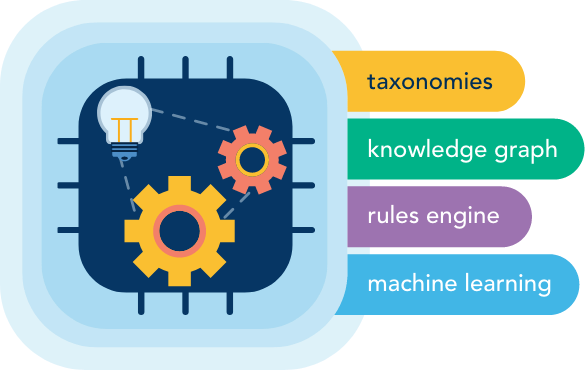
Table of Contents
- How does taxonomy drive the semantic web?
- How can I create a balanced taxonomy that’s neither too narrow nor too broad?
- How can I remove idioms and cliches from taxonomy vocabulary to avoid false positives?
- Can taxonomies be adapted to every business sector?
- What’s the difference between taxonomy and ontology?
- Is it easier to create taxonomies for source documents that use a lot of jargon?
- How can I simplify taxonomy creation at scale?
Taxonomy use is rising, as are the questions surrounding what they can do and how to get the most from them to organize content for enterprise businesses. Consider that content is 53% less effective for people who have trouble finding it. A bad content experience can negatively affect your customer relationships and impact customer views of content accuracy, relevance and usefulness.
Help is here! Expert.ai curated some common questions on taxonomy and provided answers to help you better understand how to use them.
The good news is that businesses of any size can use taxonomies to organize content and make it more useful to their business and customers. Taxonomies lay the foundation for automation, making them a crucial differentiator for any business looking for an advantage in operations and content management.
Here are seven common taxonomy questions and answers to help you understand how to become an enterprise content superpower.
1. How does taxonomy drive the semantic web?
The Semantic Web, also known as Web 3.0, is a set of standards set by the W3C that allow machines (like search engines) to understand what people mean when they type something into a website or post. They help machines to better understand and interpret human language.
Taxonomy is the foundation of the semantic web. It is used to represent and connect terms, concepts and objects together and to organize them into ontologies that represent domain areas of interest. In doing so, taxonomy helps machines understand terms in context as humans do. It is what makes it possible for machines and humans alike to interpret the meaning of words and phrases in a similar, consistent way.
2. How can I create a balanced taxonomy that’s neither too narrow nor too broad?
It’s important to prevent taxonomies from becoming so narrow that they miss important data but not too broad as to produce unwanted information. To avoid this problem, you should always test your taxonomy against your content. If a term is too broad, it will produce so many results that your taxonomy will not be useful. If a term is too narrow and only returns one piece of content out of a data set of 10,000, that’s not useful either.
This is also important when it comes to timeliness and how often your taxonomy will need to be updated. The key to finding the right balance is being pragmatic about it—you need to understand the subject area you’re working with and how fast-moving or slow-moving it is before determining how often you should review the taxonomy. For example, fast-changing taxonomies can be reviewed every six months or so, and slower moving ones can be reviewed annually.
3. How can I remove idioms and cliches from taxonomy vocabulary to avoid false positives?
Many people ask if there’s a way to remove things like idioms and cliches as a pre-filter so that your taxonomy doesn’t produce false positives based on these variants. You can leverage natural language processing (NLP) platforms with semantic analysis to analyze a term to determine whether it is an idiom or a cliche. If you’re looking at the term “hand” in a phrase like “handing down,” NLP will ensure that “hand” is not interpreted as a body part and tell you that someone is suffering from a hand injury.
You can also create filters and skill lists to eliminate those idioms. But usually, it’s easier and more accurate to rely on NLP platforms to distinguish terms and idioms.
4. Can taxonomies be adapted to every business sector?
Taxonomies can be adapted to any business sector so long as there is enough content to classify. If enough information is available, you will not be limited in terms of the domains that can be addressed, nor how you choose to represent the information. Companies that don’t want to build out taxonomies on their own can use NLP systems to plug into existing taxonomies that have already been implemented and have knowledge models created, similar to that offered by expert.ai. One thing that could limit the effectiveness of a taxonomy for a specific sector is the amount of domain expertise contributing to the creation of the taxonomy and understanding the business goals that will leverage the taxonomy for output.
For more information on building taxonomies for your business, see our post, How To Use Taxonomies: An Enterprise Success Story.
5. What’s the difference between taxonomy and ontology?
The essential difference between taxonomy and ontology is that taxonomy is more concerned with how you classify objects, while ontology concerns itself with how objects relate to each other. Taxonomies assign categories to objects, while ontologies specify the relationships between them.
So, you could have a taxonomy about rodents and squirrels and yet another hierarchy about nuts, but there’s no associative relationship between red squirrels eating hazelnuts. That’s what ontology delivers: It tells you what that relationship is.
6. Is it easier to create taxonomies for source documents that use a lot of jargon?
The short answer is no. The source documents you’re working with can introduce a lot of company- or industry-specific jargon, making it difficult to create a taxonomy for them. And sometimes, it’s not always easy to clarify the terminology—you may have one term that is used in multiple contexts.
You can still create a taxonomy for your source documents. The best approach is to capture the jargon in your controlled vocabulary as extra information, so that users can search using this terminology and still find what they’re looking for. This ensures that your content is discoverable.
7. How can I simplify taxonomy creation at scale?
There are several options for simplifying the taxonomy creation process. For example, you can use existing taxonomies. TaxoBank is an online database of taxonomies and vocabularies. You can search their database on the website or use their API to access it systematically. It’s also a good resource for finding artificial intelligence taxonomies, as they cover AI and many other areas.
Wand is another bank of foundational taxonomies that can be used as a starting point and reduce the time spent developing and customizing your taxonomies
If you’re looking for a European-specific cybersecurity taxonomy, the European Cyber Security Taxonomy maintained by the Cybersecurity Organization of the European Union is a great resource.
With the expert.ai platform, we help companies programmatically build a taxonomy to classify content at scale by:
- Using machine learning algorithms to identify relevant terms
- Determining relationships between terms
- Automating the creation of a hierarchical structure for your taxonomy
Want to build a taxonomy to power your content, documents, web pages, social media, articles and other language-based assets? Reach out to get started.


